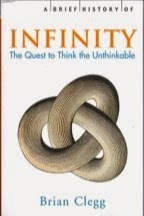Brian Clegg's Blog, page 84
November 25, 2014
Proving the irrational
 When writing about science we often have to fight against irrational ideas that seem to grow on people's minds like fungi. Yet early mathematicians had the opposite problem of requiring the irrational. This was the irrational in the literal sense - a number that is not made up of a ratio. According to myth, when one of Pythagoras' merry band discovered that the length of a diagonal of a square with sides of length one (the square root of 2) was not a rational number (a fraction that's the ratio of two whole numbers), he was drowned for spreading such a malicious concept.
When writing about science we often have to fight against irrational ideas that seem to grow on people's minds like fungi. Yet early mathematicians had the opposite problem of requiring the irrational. This was the irrational in the literal sense - a number that is not made up of a ratio. According to myth, when one of Pythagoras' merry band discovered that the length of a diagonal of a square with sides of length one (the square root of 2) was not a rational number (a fraction that's the ratio of two whole numbers), he was drowned for spreading such a malicious concept.What's interesting, as I describe in my book A Brief History of Infinity , is that there is a remarkably simple proof that √2 is irrational. It requires little more than an understanding of odd and even and goes something like this:
Let's assume √2 can be represented by a rational fraction - we'll call it top/bottom.
To keep things simple, we are assuming that top/bottom provides the simplest fraction you can get - there's nothing to cancel out, so it's like 1/2 rather than 2/4. So:
top/bottom =√2
Square roots are a bit fiddly, so let's multiply each side of the equals sign by itself. This gives us
top2/bottom2 = 2
In traditional mathematical fashion, we can get rid of the division by multiplying both sides of the equation by bottom2, giving us:
top2 = 2 x bottom2
Next, the Greeks relied on their knowledge of odd and even numbers. They knew three things about odd and even numbers.
A number that can be divided by 2 is even.If you multiply an odd number by an odd number, you get another odd number.If you multiply any number (odd or even) by an even number, you get an even number.As the right-hand side of the equals sign is 2 x bottom2, it must be even - it's the outcome of multiplying by an even number, 2. So top2 also must be even. And that means top has to be even (because were it odd we would be multiplying two odd numbers together and would get an odd result).
Now here comes the twist. If top is even, then it can be divided by 2. So top2 can be divided by 4. And we know that top2 is the same as 2 x bottom2. If 2 x bottom2 can be divided by 4, then bottom2 can be divided by 2. So bottom2 (and hence bottom) is even. (Read that again if necessary - it makes sense.)
So both top and bottom are even. But if both are even, then top/bottom isn't the simplest fraction we could have, since we can divide both top and bottom by 2. Yet we started by saying that top/bottom was the simplest fraction we could have. We've reached an impossible contradictory situation - which means our original assumption that it was possible to represent √2 by a ratio was false.
Added: Thanks to Thony Christie for pointing out that it's thought the Pythagoreans first discovered that √5 was irrational - but because √2 is based on the diagonal of a unit square, I think it makes the simplest example.
Published on November 25, 2014 00:59
November 24, 2014
The joy of being tech support
 For a while when I worked at British Airways I was in charge of the department that did all the support for PC users - and I was also one of BA's first PC programmers - so I think it's fair to say that I know more about computers than most people of my generation. This can be handy. But the downside is that the family regard me as official PC support guy.
For a while when I worked at British Airways I was in charge of the department that did all the support for PC users - and I was also one of BA's first PC programmers - so I think it's fair to say that I know more about computers than most people of my generation. This can be handy. But the downside is that the family regard me as official PC support guy.This came home with a bang when one of my daughters reported one of the weirdest errors I've come across. Every time she tried to save something in Word the above error box came up. She couldn't save a single file. Even with the default Document1 filename. Yet other programs - Powerpoint for instance - were fine. Word is something she uses heavily on her course, so it needed sorting, but what could possibly be happening?
At the time the laptop was at university and I was at home, so several local attempts were made to sort it out without success. This weekend I finally got my hands on it and spent a couple of hours tidying up various bits and pieces, plus fully de-installing and reinstalling Office. End result? No change.
I was under a bit of pressure, as I had a train to catch. But three minutes before I was due to leave I had a really silly idea. And 2 minutes and 50 seconds before I was due to leave, I had fixed the problem. What it comes down to is a subtle divergence between Word, with its Windows background, and the Mac's OS X operating system, which is basically a tarted up version of Unix. Windows comes from a DOS heritage where filenames were very limited. Who remembers names that had to be no more than 8 characters in length? And there were lots of forbidden characters in filenames. Windows has loosen up since then, but there are still a number of limitations on what can appear, and this proved to be the secret to fixing the problem.
It might seem this doesn't make any sense - after all I was trying out totally legitimate filenames. But the whole path that specifies where the file is located also had to meet with Word's approval. And at some point, the hard disc of the computer had been accidentally renamed ]q - which the Mac had no problems with. But this meant that file's path, which includes the name of the hard disc, had a ']' in it, which Word didn't think was possible.
So there are three problems here the developers should have spotted and prevented. First, by default the Mac puts an icon for the hard disc on the desktop, which makes it far too easy to accidentally rename it. (Easily removed, but it's probably a mistake to have it there in the first place.) Secondly Word, like Powerpoint, should have coped with all possible Mac file naming possibilities. And thirdly the Word error message should have been a lot more explicit, rather than leaving you guessing just what it was complaining about.
Sigh. Computers, eh?
Published on November 24, 2014 00:53
November 21, 2014
An old one but a good one
 Thanks to Peet Morris for reminding me of this little puzzle for the weekend.
Thanks to Peet Morris for reminding me of this little puzzle for the weekend.Multiple choice:
If you choose an answer to this question at random, what is the chance you will be correct?:
A) 25%
B) 50%
C) 60%
D) 25%
I'm not going to suggest a 'right' answer (though there are at least two) - I leave it up to you.
Published on November 21, 2014 03:04
November 20, 2014
The most obscure physics laureate?
We all love a good Nobel Prize, but every now and then there is a flare up over the winners. Sometimes it is because of the arbitrary restriction to three winners who must be alive at the time of the award. Sometimes, as when Jocelyn Bell appeared to be pushed aside for her boss Anthony Hewish (much to the irritation of Fred Hoyle), it is an apparent unfairness. But most often, I suspect, in the case of the physics Prize it is due to the Prize committee's inability to decide just what physics is.
There have been a number of examples of awards that were really for inventions or technology. Admittedly these inventions were usually based on physics - but it would be tenuous to call them a fundamental breakthrough in physics itself, as the inventors were making use of an existing physical concept. So, for instance, the award for the laser (or more accurately the maser, as neither Gordon Gould nor Theodore Maiman were included, arguably the key names for the laser) should arguably have gone to Einstein, who came up with the theory in the first place.
But one thing the dalliance with inventions gives us is the inclusion of the man who must, surely, be the most obscure physics Nobel laureate ever: Gustaf Dalén. Without peeking below, I challenge anyone from working physicists to those with a casual interest in science to say what Dalén achieved to win the 1912 prize.
Here's his picture to consider while you work it out:
 Gustaf Dalén: public domain image from
Gustaf Dalén: public domain image from
Nobel Prize website
You must admit, he looks cool. Possibly the hero of a steampunk romance.
Okay have you guessed? Have one more attempt before the reveal.
Gustaf Dalén won his prize for his 'invention of automatic regulators for use in conjunction with gas accumulators for illuminating lighthouses and buoys.'
Not only was there no real physics here, the control of gas-lit lighthouses is not exactly going to have a long-term impact on life, the universe and... well, anything really.
Nice one, Gustaf.
There have been a number of examples of awards that were really for inventions or technology. Admittedly these inventions were usually based on physics - but it would be tenuous to call them a fundamental breakthrough in physics itself, as the inventors were making use of an existing physical concept. So, for instance, the award for the laser (or more accurately the maser, as neither Gordon Gould nor Theodore Maiman were included, arguably the key names for the laser) should arguably have gone to Einstein, who came up with the theory in the first place.
But one thing the dalliance with inventions gives us is the inclusion of the man who must, surely, be the most obscure physics Nobel laureate ever: Gustaf Dalén. Without peeking below, I challenge anyone from working physicists to those with a casual interest in science to say what Dalén achieved to win the 1912 prize.
Here's his picture to consider while you work it out:
 Gustaf Dalén: public domain image from
Gustaf Dalén: public domain image fromNobel Prize website
You must admit, he looks cool. Possibly the hero of a steampunk romance.
Okay have you guessed? Have one more attempt before the reveal.
Gustaf Dalén won his prize for his 'invention of automatic regulators for use in conjunction with gas accumulators for illuminating lighthouses and buoys.'
Not only was there no real physics here, the control of gas-lit lighthouses is not exactly going to have a long-term impact on life, the universe and... well, anything really.
Nice one, Gustaf.
Published on November 20, 2014 01:49
November 19, 2014
A zap from the sun
 Image by Fir0002/Flagstaffotos from WikipediaI've always loved the science of lightning, hence, for instance the piece I wrote for the Observer. At the time I mentioned a theory linking cosmic rays to lightning strikes as, surprisingly, we really don't know a lot about why lightning occurs. Now there's some brand new (published today) research that suggests the Sun may be playing a part in the generation of lightning strikes by temporarily ‘bending’ the Earth’s magnetic field and allowing the shower of energetic particles that makes up cosmic rays to enter the upper atmosphere.
Image by Fir0002/Flagstaffotos from WikipediaI've always loved the science of lightning, hence, for instance the piece I wrote for the Observer. At the time I mentioned a theory linking cosmic rays to lightning strikes as, surprisingly, we really don't know a lot about why lightning occurs. Now there's some brand new (published today) research that suggests the Sun may be playing a part in the generation of lightning strikes by temporarily ‘bending’ the Earth’s magnetic field and allowing the shower of energetic particles that makes up cosmic rays to enter the upper atmosphere.According to the IOP, 'researchers at the University of Reading who have found that over a five year period the UK experienced around 50% more lightning strikes when the Earth’s magnetic field was skewed by the Sun’s own magnetic field. The Earth’s magnetic field usually functions as an in-built force-field to shield against a bombardment of particles from space, known as galactic cosmic rays, which have previously been found to prompt a chain-reaction of events in thunderclouds that trigger lightning bolts.'
Lead author of the research Dr Matt Owens said: 'We’ve discovered that the Sun’s powerful magnetic field is having a big influence on UK lightning rates. The Sun’s magnetic field is like a bar magnet, so as the Sun rotates its magnetic field alternately points toward and away from the Earth, pulling the Earth’s own magnetic field one way and then another.'
In their study, the researchers used satellite and Met Office data to show that between 2001 and 2006, the UK experienced a 50% increase in thunderstorms when the heliospheric magnetic field pointed towards the Sun and away from Earth. This change of direction can skew the Earth’s own magnetic field and the researchers believe that this could expose some regions of the upper atmosphere to more cosmic rays.
'From our results, we propose that galactic cosmic rays are channelled to different locations around the globe, which can trigger lightning in already charged-up thunderclouds. The changes to our magnetic field could also make thunderstorms more likely by acting like an extra battery in the atmospheric electric circuit, helping to further "charge up" clouds,' Dr Owens continued. The results build on a previous study which found an unexpected link between energetic particles from the Sun and lightning rates on Earth.
'Scientists have been reliably predicting the solar magnetic field polarity since the 1970s by watching the surface of the Sun. We just never knew it had any implications on the weather on Earth. We now plan to combine regular weather forecasts, which predict when and where thunderclouds will form, with solar magnetic field predictions. This means a reliable lightning forecast could now be a genuine possibility.'
This paper can be downloaded from the IOP here.
Published on November 19, 2014 00:30
November 18, 2014
Science writing one hit wonders
 I'm in the process of transferring the Popular Science book review site (www.popularscience.co.uk) to a new home after getting fed up with Wordpress.
I'm in the process of transferring the Popular Science book review site (www.popularscience.co.uk) to a new home after getting fed up with Wordpress.The old site (about the fourth incarnation since 2004), was hosted on my own website using Wordpress, but it was a nightmare to keep up to date. They kept updating Wordpress and its plugins with nauseating regularity, and I could never get the automatic updates to work, so had to update it by hand each time. For a while it has been close to the maximum memory my ISP allocates to a virtual server, and the latest version crashed through this so that it was impossible to update the site ever again.
One advantage of moving it to a new site is that I've taken the opportunity to add a couple of features missing from the Wordpress version, notably an alphabetical set of index pages by author. And what's quite surprising is how many one hit wonders there are. If you take a look, for instance, at the S authors, one of the more popular surname initial letters, out of 51 authors, only 6 have more than one book listed. (I am still updating the site, so there may be more by the time you read this.)
One interpretation of this is that popular science writers are primarily amateurs (at writing). Another is that most aren't very good. Or are very slow writers. Or didn't earn as much as they expected. (Or hated our review and wouldn't send another book in case that one was slated too.) All of the above, I suspect, and other reasons too. But interesting nonetheless.
Incidentally, the site is up for the UK blog awards. If you've got a few moments to spare, it would be great if you could pop along and vote for it! It should only take a few seconds.
Published on November 18, 2014 00:17
November 17, 2014
Politicians need science advisors - and not to be swayed by single interest groups
 Image from BBC websiteI am totally disgusted by the EU. Not in a generic UKIP fashion, but by their cancellation of the position of EU Chief Scientific Advisor, a post held by Professor Anne Glover, otherwise based at the University of Aberdeen.
Image from BBC websiteI am totally disgusted by the EU. Not in a generic UKIP fashion, but by their cancellation of the position of EU Chief Scientific Advisor, a post held by Professor Anne Glover, otherwise based at the University of Aberdeen.There are two problems with this. The first is that politicians are in dire need of science advice. We (and the EU as a whole) have very few politicians and civil servants with a science background. It is essential that they have advisors who can explain the scientific realities of a world where science and technology is central to our everyday lives. To abolish the post is madness.
Secondly, the reason that Professor Glover seems to have got her marching orders is a result of a campaign by green groups, and specifically Greenpeace, which objected to her support for genetically modified crops. Just like they do for nuclear power, such groups have a knee-jerk reaction to GM that has no thought, no appreciation of the science, they just don't like the words.
The green blanket opposition to GM just doesn't make any sense, because it's something we've been doing for thousands of years (if you doubt this, take a look at maize and cauliflowers, both so drastically genetically modified that they can't reproduce without human intervention) - and because we can now do it in a much more controlled and beneficial fashion.
The GM debate is admittedly not simple or black and white, but it has certainly been subject to the misuse of information from both green organisations, which oppose it on principle without thinking about it in detail, and from tabloid newspapers. For example, genetically modified variant of rice that was designed to counter vitamin A deficiency was dismissed by Greenpeace because the environmental organisation said that to obtain the required amount of vitamin A would require ‘seven kilograms a day of cooked Golden Rice’. The actual amount is 200 grams.
So shame on you Greenpeace (who have tried to weasel out by saying that 'Scrapping the CSA post was about the integrity of science advice, the clarity and independence and it's about getting the science right' - since when has Greenpeace cared about getting science right?) for engineering this highly negative move.
We need more MPs and MEPs with a science background - but even if we had them today, party politics and, yes, the malign influence of pressure groups both from industry and the greens, means that we also need good science advisors. Professor Glover will be sorely missed.
This has been a Green Heretic production
Published on November 17, 2014 01:33
November 13, 2014
Where were the world's first computer animations produced?
 Part of one floor of the Atlas installation
Part of one floor of the Atlas installation(courtesy Rutherford Appleton Laboratory and
the Science and Technology Facilities Council (STFC))We are all so used to CGI that it's not even a surprise these days when the effects on Dr Who are passable. But 50 years ago, things were very different. Usually the only computer animation you could expect was watching the punched tape or cards fly through the reader. But where was the first seed planted for the future wonders of CGI that would make practically any modern science fiction or action film possible? Was it MIT? Hollywood? No, it was Oxfordshire. In the wonderful Rutherford Appleton Laboratory.
Let me hand you over to Marion at the Science & Technology Facilities Council (based in sunny Swindon):
UK computing is today celebrating fifty years since the launch of what was at that time the largest supercomputer in the world, the Atlas 1. When built it was the size of a large detached house. Now that same computing capacity would fit in your pocket inside your mobile phone.
In 1964, the Rutherford Appleton Laboratory (RAL) in Oxfordshire opened the UK’s first purpose-built computer laboratory to house one of the world’s first supercomputers. Not only did this facility go on to produce the world’s first computer animated films during the mid-seventies it also contributed the 3D wire-frame model shown on the navigation monitors in the landing sequence of the Ridley Scott film ‘Alien’ – making it the Industrial Light and Magic or Weta computer animation facility of its day.
The Ferranti Atlas 1 computer was the largest of three world leading computers built in the UK. It cost around £3M – equivalent to about £80M in today’s currency – and was so enormous the Atlas Computer Laboratory, as it was known then, was built to fit the computer.
This week, on 13 – 14 November, the Science and Technology Facilities Council (STFC) is opening RAL’s doors to celebrate those 50 years of supercomputing, with a series of talks, tours and exhibits to highlight the importance of this computer facility to society today.
In the 1960s and 70s, universities and other research establishments that needed to use computing facilities had to put their program and data onto punch cards and post them to the Atlas Computing Laboratory, where their program would be run for them.
Dr Andrew Taylor, Executive Director, STFC National Laboratories, said, “Since those early days, computing at RAL has gone from strength to strength, and the Atlas Centre is now home to Tier One – where data from the Large Hadron Collider is stored in the UK, as well as a range of other facilities such those which process data from weather satellites. Fifty years on, the technology is so far advanced that a mobile phone is more powerful and far cheaper than the Atlas computer.”
The Atlas processor used more than 5,600 circuit boards, which would have covered an area about the size of a tennis court – around 90,000 times bigger than a modern computer chip. One of its discs could hold just two photographs, whereas today’s equivalent, the USB stick, can store thousands of images.
The original Atlas Computer Laboratory established a national computing operation to support scientific research. Since 1964 that UK computing operation has been a part of many technical and scientific innovations. It has contributed to the governance of the World Wide Web; it has managed the data which led to the discovery of the Higgs boson, and it continues to support major scientific experiments at facilities in the UK and internationally.
The world's first computer animations were produced at the laboratory. These included an animated model of stress-loading across an M6 motorway bridge that was being built at the time. It was the first entirely computer-produced engineering film to be made in the UK and won the Great Britain entry in the 1976 international Technical Films Competition in Moscow. Most famously, the laboratory's facilities were used to produce the 3D wire-frame model shown on the navigation monitors in the landing sequence of the Ridley Scott film ‘Alien’, which won the 1979 Academy Award for best visual effects.
People touring the Atlas Centre exhibits during these 50th Anniversary celebrations will discover the rich history of computing innovations at RAL, from the very beginning of supercomputers to the endless possibilities of today.
Dr Taylor added, “We are particularly excited that, in its 50th anniversary year, we are able to display the console from the original Atlas computer, together with memorabilia of the time.”
Though the Atlas computing operation has gone from strength to strength the Ferranti Atlas 1 itself closed in March 1973 and was replaced by an ICT1906A. In the eight years of operation it had run for 44,500 hours with a 97% up time. 836,000 jobs were run, 300 million cards read, 4000 million characters from paper tape read, 800 million lines of line-printer output generated and 17 million cards punched.
You can read more about Atlas at its website. Here are those groundbreaking wireframe graphics in a clip from Alien, but it French to make it more noir:
Published on November 13, 2014 00:50
November 12, 2014
When scientists show their claws
 The unfortunate Thomas YoungWith their media of image of being cool, emotionless brainboxes, it might be surprising to learn that scientists can be just as catty as anyone else, and though science is a collaborative business where it's par for the course to tear apart other people's theories and then go out for a drink with them, it's still the case that personal dislikes sometimes triumph over rational argument.
The unfortunate Thomas YoungWith their media of image of being cool, emotionless brainboxes, it might be surprising to learn that scientists can be just as catty as anyone else, and though science is a collaborative business where it's par for the course to tear apart other people's theories and then go out for a drink with them, it's still the case that personal dislikes sometimes triumph over rational argument.One of the most famous scientific quotes in history, from Isaac Newton is often thought to be a masked insult. Newton, writing to his hated arch rival Robert Hooke, approximately quoted a line from Robert Burton when he wrote 'If I have seen further it is by standing on the shoulders of Giants.' The reason many think this was a piece of nastiness was not just because Newton was making it clear that he didn't owe much to Hooke, but also because Hooke was anything but a giant physically.
The scientific claws come out in all kinds of subtle ways. I'm currently reading a new book on quantum biology by Jim Al-Khalili and Johnjoe McFadden. In one chapter, Al-Khalili (I assume it's him, as this is a reference to quantum physics) makes the effort to point out four times that quantum entanglement does not produce 'paranormal effects' (his inverted commas) like telepathy. He refers to those who come up with such theories as charlatans and uses what, since the Simon Singh/BCA affair must now be considered the 'B' word when he says: 'despite the bogus claims of telepathy.'
You might think this is just general commentary rather than backbiting. However, if you know the quantum entanglement field, it's hard not to be aware that Nobel Prize winning physicist Brian Josephson has publicly suggested that there might be an explanation for telepathy in quantum entanglement. Which does put these remarks in a whole new light.
However, my favourite insult is probably one I've just revisited in preparing a new edition of my first popular science book Light Years . When Thomas Young first came up with his evidence that Newton was wrong and that light was, as Descartes, Huygens and others had suggested, a wave, he got considerable opposition from the British establishment. I want to leave you with the commentary in the Edinburgh Review from Henry Brougham, at the time a young lawyer and writer, and later Lord Chancellor. (Thanks, by the way, to John Gribbin for pointing out that this is probably a double insult, as the reference to the 'ladies of the Royal Institution' may well be a dig at the way the head of that then upstart institution, the Brian Cox of his day, Humphrey Davy, had a reputation for making the ladies swoon.)
We may now dismiss for the present, the feeble lucubrations of this author, in which we have searched without success for some traces of learning, acuteness or ingenuity that might compensate his evident deficiency in the powers of solid thinking, calm and patient investigation, and successful development of the laws of nature by steady and modest observation of her operations. Has the Royal Society so degraded its publications into bulletins of fashionable theories for the ladies of the Royal Institution? Let the Professor continue to amuse his audience with an endless variety of such harmless trifles, but in the name of Science, let them not find admittance into the venerable repository which contains the names of Newton, Boyle, Cavendish...Image from Wikipedia
Published on November 12, 2014 01:37
November 11, 2014
Taking the tablet
 Effortlessly editing a script in Word for iPadI do technically have a laptop, but I hardly ever use it. Ever since I've had an iPad, the tablet has been my sturdy companion when working away from home. Why would I want to carry a heavy, delicate beast like a laptop when I've everything I need in a compact package with a battery life that means I can work on it all day?
Effortlessly editing a script in Word for iPadI do technically have a laptop, but I hardly ever use it. Ever since I've had an iPad, the tablet has been my sturdy companion when working away from home. Why would I want to carry a heavy, delicate beast like a laptop when I've everything I need in a compact package with a battery life that means I can work on it all day?I can touch type on the onscreen keyboard - okay, a little slower than a real one, but not much. It is the perfect working companion for a train journey or an overnight in a hotel. But there was a tiny fly in the ointment. And that was the lack of Office.
Not having Office was, frankly, a pain. I made use of a perfectly respectable alternative, that pretty much read and wrote Office files, but like all such second-bests it wasn't quite the real deal. The Word equivalent lost some of the formatting, while the Powerpoint handling didn't show animations, which practically every Powerpoint I use has.
So it was great when Office for iPad eventually came out - except for another issue. To do anything other than read a document, you needed an Office 365 subscription. Now I do intend to cut over to this - but not until they bring out the new Office for Mac, which isn't expected until second half of 2015.
However, Microsoft has finally seen the light. The new release of Office for iPad (which also works on iPhones) is almost full-functioned. There are a few small things missing you need Office 365 to get, but nothing I regularly use. With joy, I could throw away my old compatiblish app and it's Office all the way. So now I genuinely can say that I can't imagine ever using my laptop again.
To make the replacement seem complete, although I rarely actually want to print from my iPad, it seemed reasonable to get printing up and running as I very occasionally need to do this at home. I don't have an airPrint printer, and treasure my 12-year-old laser printer, which is a solid a battleship, so I had to look for alternatives. I'm currently in the trial period for Printopia (HT to Mark Hogarth), which seems to do the job excellently.
I think I'll keep taking the tablet...
Published on November 11, 2014 01:15



